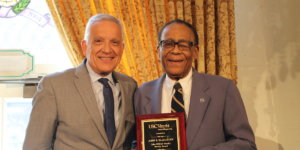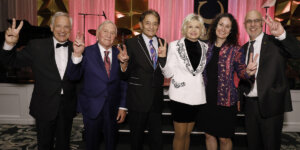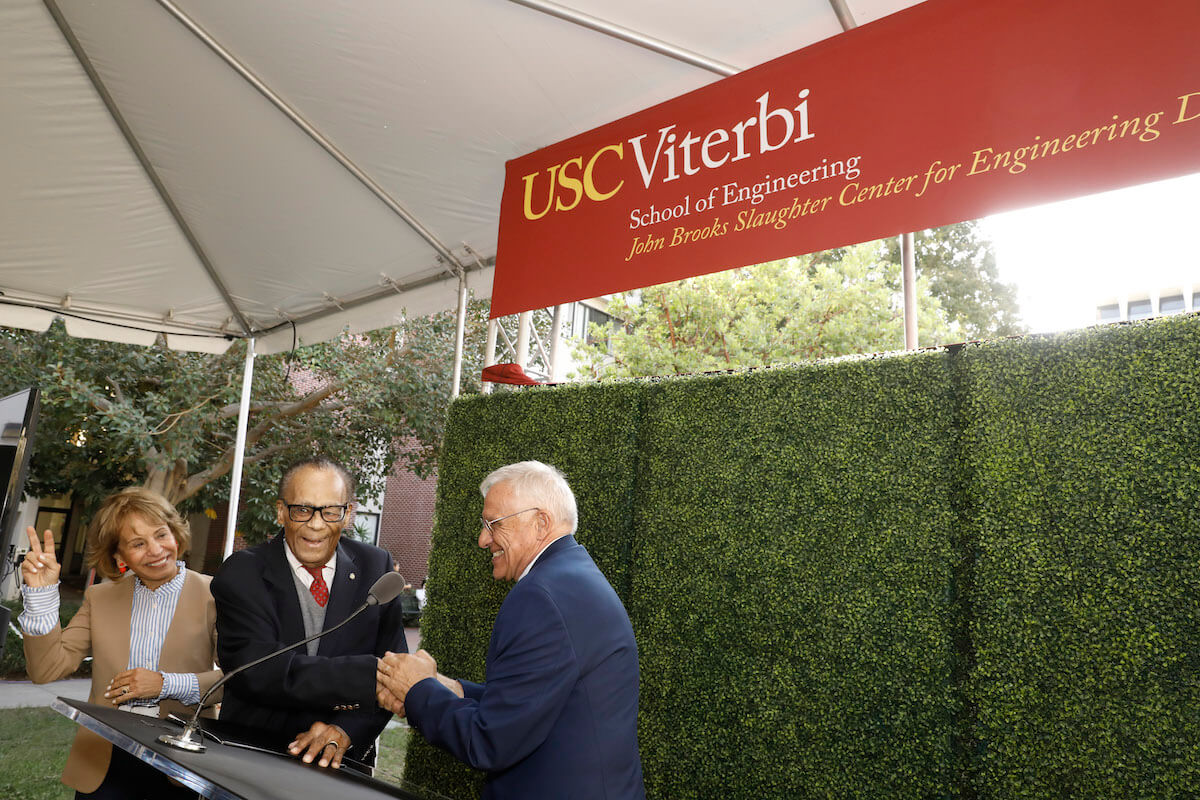
“LIFT AS WE CLIMB” THE USC COMMUNITY CELEBRATED THE OFFICIAL UNVEILING OF THE JOHN BROOKS SLAUGHTER CENTER FOR ENGINEERING DIVERSITY ON WEDNESDAY, SEPTEMBER 20. PHOTO/STEVE COHN.
The USC Viterbi School of Engineering’s Center for Engineering Diversity is undergoing a transformation that transcends mere nomenclature. Etched into its name, the center will now have a story that personally embodies a quest for diversity, excellence and equity – one that honors a man whose life has been a testament to the very ideals it champions: John Brooks Slaughter.
Slaughter’s journey through the annals of engineering, education and leadership is akin to a symphony of progress, with each note a milestone in the struggle for a more inclusive and equitable world. On September 20th, 2023 at USC Viterbi’s Epstein Family Plaza, that symphony was celebrated in a naming ceremony commemorating the new John Brooks Slaughter Center for Engineering Diversity.
“We are here to forever link USC engineering with an engineering education legend,” said USC Viterbi Dean Yannis C. Yortsos. “I cannot hide my pride in being part of this extraordinary, historic moment.”
Slaughter’s trailblazing accomplishments include being the first Black director of the National Science Foundation (NSF), the first Black president of Occidental College and the first Black chancellor of the University of Maryland. Slaughter joined USC in January of 2010 as a USC Viterbi distinguished professor of engineering with a joint appointment at the USC Rossier School of Education, but his legacy extends far beyond titles and accolades.
“All his life, our friend John Brooks Slaughter has lived the words: “lift as we climb,” USC President Carol Folt explained to an audience of faculty, staff, and students. “He has spent decades helping others climb to new heights – in engineering, education, public life, and simply as humans. Now we have a center whose name will keep his story front and center.”
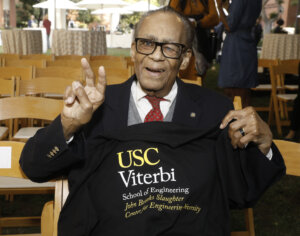
John Brooks Slaughter at the naming event celebration for the John Brooks Slaughter Center for Engineering Diversity. Photo/Steve Cohn.
CHANGING THE CONVERSATION ABOUT ENGINEERING SINCE 1975
The Center for Engineering Diversity (CED) traces its origin to 1975, when MEP (Minority Engineering Program) was created, making USC the first private university in California to fund a program focused on the recruitment, retention and graduation of African-American, Hispanic, and Native American students, long before the current attention to this important issue. Its name was changed to CED in 1997.
“Today, we celebrate a concept, an idea, a commitment, and a program. And we honor John Brooks Slaughter, arguably the most important Black engineer in American history, who personalized and nurtured these concepts and these commitments and made them grow and flourish nationally” Dean Yortsos said at the festive event held at the Epstein Plaza.
“Created in 1975, the program was designed to fill a tremendous need that was as evident then as it is now,” said Ken Bonner, USC Viterbi associate dean for inclusion and diversity initiatives.
“If CED didn’t exist at Viterbi, our school would lack a vibrant and diverse community that enriches learning and innovation for all and would be missing that illuminated pathway for aspiring engineers to foster a brighter and more inclusive future. Simply put, it would be missing its heart and soul.”
Slaughter became an integral part of the CED community, embodying a student-centered approach by casually joining students for lunch at the center, and engaging them in conversations about life, career and current events.

Snapshots from the very beginning of the Minority Engineering Program at USC Viterbi.
In 2011, his commitment took another meaningful turn as Slaughter partnered with CED staff to establish a Faculty Advisory Board. The board worked tirelessly to create pipelines to research and mentoring opportunities between faculty and CED students. In doing so, it helped bridge the gap between students and faculty, fostering a sense of unity and shared purpose that has become the hallmark of CED’s success.
In 2015, at the annual engineering deans meeting, held in South Carolina, John Brooks Slaughter was a key panelist on a session on engineering representation, chaired by Dean Yortsos. The outcome of that session was a pledge to redouble efforts to increase representation in engineering. By mid-August 2015 more than 100 engineering deans had signed this pledge. Today, more than 250 engineering schools have committed to it, which has become a signature national initiative of the American Society of Engineering Education. In recognition of this effort, USC Viterbi received in 2017 the ASEE President’s award, rarely given to an engineering school.
“As we look to the future, the renaming of the Center for Engineering Diversity to honor Dr. John Brooks Slaughter is more than a symbolic gesture,” said Traci Thomas Navarro, director of the John Brooks Slaughter Center for Engineering Diversity. “It’s a declaration that his life’s work will continue and it’s a recommitment to his vision.”
THE CLIMB TO THE TOP
In 1934, amidst the backdrop of a segregated Topeka, Kansas. John Brooks Slaughter’s remarkable story began. From his earliest years, Slaughter harbored an unwavering ambition — to become an engineer, a dream he passionately shared with anyone willing to listen.
Reflecting on those early years, Slaughter recalled: “I remember telling my high school counselor about my dream, and the counselor’s response was, ‘Hahaha, you should consider trade school and learn how to repair radios.’ I was too dumb to know what was happening to me, so I ended up going to trade school and learned how to repair radios. When I graduated from high school I had good grades, but I hadn’t taken the courses I needed to take to go to engineering school. It was a tragedy for me in those days.”
However, Slaughter was determined to turn that tragedy into triumph. He earned a Bachelor of Science in electrical engineering from Kansas State University in 1956, a master’s degree in engineering from the University of California, Los Angeles in 1961, followed by a Ph.D. in engineering sciences from the University of California, San Diego in 1971.
After an early career as an engineer at the United States Navy Electronics Laboratory, Slaughter took on the role of director at the Applied Physics Laboratory at the University of Washington. In 1977, he assumed the position of assistant director for Astronomics, Atmospherics, Earth, and Ocean Sciences at the National Science Foundation (NSF). His return to academia occurred in 1979 when he became provost at Washington State University.
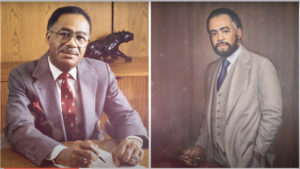
Pictures of John Brooks Slaughter during his time serving as the first Black President of The National Science Foundation.
The pivotal year of 1980 marked a significant turning point in Slaughter’s life when he received an unexpected phone call. President Jimmy Carter himself reached out, urging him to accept the nomination as the director of the National Science Foundation (NSF). This moment would propel him into a new realm of influence and leadership in the world of science and engineering.
In 2015, he was honored at the White House with the Presidential Award for Excellence in Science, Mathematics and Engineering Mentoring.
It was during an engaging talk for a USC Dornsife series titled “What Matters to Me and Why” that Slaughter delivered a profound message on his beliefs about diversity. In a dimly lit auditorium, his words pierced the silence like a beacon of wisdom. “Diversity is not something that in and of itself means we have accomplished a great deal.”
He continued, driving the point home with vivid examples: “A penitentiary is diverse, but no one wants to be there because there is no excellence and equity there. A plantation is diverse, but there is no equity or excellence there either. What really is meaningful is the presence of equity and excellence.”
Now, the renaming of CED underscores the importance of equity and excellence as well. It’s a symbol of recognition for the countless aspiring engineers who may have faced adversity, much like Slaughter did – while serving as a fitting tribute to a man whose remarkable journey exemplifies the very spirit of perseverance and ambition that drives the field of engineering forward.
“To have the center named after me is greater than any honor I’ve ever received,” Slaughter said.
For more information on how to get involved with The John Slaughter Center for Engineering Diversity located in RTH 210, click here.
Published on September 21st, 2023
Last updated on September 21st, 2023





